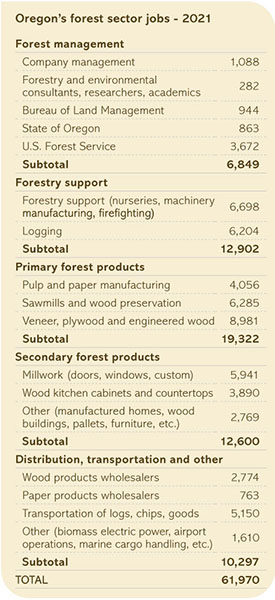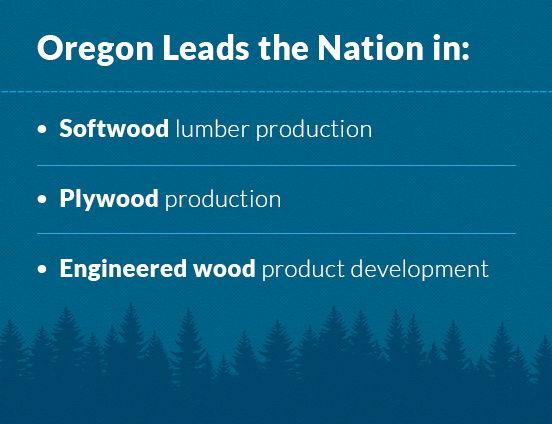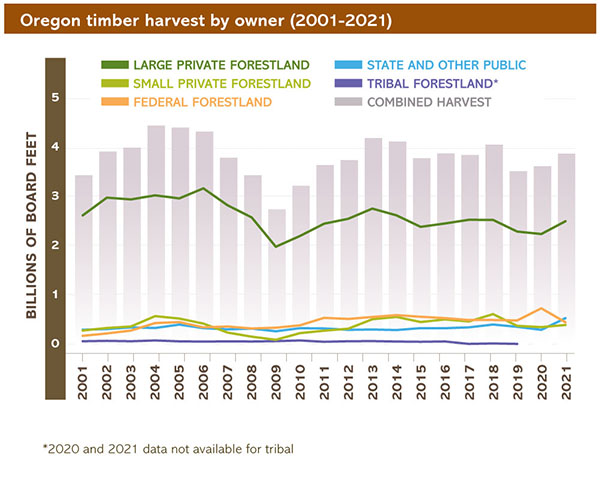
Many communities throughout Oregon, especially those in rural areas, depend on forests for their livelihood. According to the most recent statistics, Oregon’s forest sector supports more than 61,000 direct jobs throughout the state in forest management and forest products manufacturing and distribution - about 3 percent - of total statewide employment.
Rural communities have logged and cared for nearby federal forests for decades. These forests provided jobs for the community. And through an agreement with the federal government, 25 percent of U.S. Forest Service and 50 percent of Bureau of Land Management timber revenue went to help fund education, road construction, public libraries and fire and police protection. However, since the implementation of the Northwest Forest Plan in 1994, timber harvesting in federal forests has decreased significantly, leaving many people without jobs and the communities without the amount of monetary support necessary for essential services such as public safety. A decline in forest health and fire resiliency is another result of passive management, especially in Oregon’s dryer eastern forests. Increased active management of federal forestland can improve the overall health of a forest ecosystem, while leading to stronger, healthier communities that make a positive contribution to the state’s overall economy.
Federal programs designed to help financially support these communities ended in 2015, resulting in untouched federal foretlands growing increasingly susceptible to fire and insect infestation, while communities of forest professionals leave to find work elsewhere.
Forest jobs
Oregonians are employed in a variety of forest-related jobs, from forestry, logging, millwork and cabinetmaking to engineering, hydrology, business management and academic research. This is what is known as the “forest sector.” The sector encompasses a diverse array of career paths that include firefighters, ecologists, park rangers, wildlife and fish biologists, and more.
Advances in technology in wood products manufacturing, logging, forest management and digital forest mapping often require specialized training and education. In 2021, the average annual wage for Oregon forest sector jobs was $68,200, three percent higher than the average wage of $64,000 for all Oregon employment.
Economists estimate that each million board feet of timber harvested in Oregon creates or retains about 11 forest sector jobs.
Here’s a rundown of Oregon’s forest sector jobs by type of employment for 2021:

Forestry and wood products across the state
Oregon’s wood products industry is a traded sector, with close to 75 percent of all products made here sold outside the state. This state dominates U.S. production of softwood lumber and plywood. Today it is also a leader in engineered wood, and home to the first mill in the United States to manufacture structurally certified cross-laminated timber (CLT).
Forest sector jobs are present in 35 of Oregon’s 36 counties. In some rural counties, the sector is responsible for nearly a third of the economic base. But the overall economic impact of forests is different for every county. This is because the forest landownership, timber harvest levels, forest sector employment and the number of mills in each county can vary widely.
To see how your county compares to the statewide forestry and wood products industry, download a county economic fact sheet:
State and County Economic Fact Sheets

Timber harvest levels
Forests remain Oregon’s most abundant natural resource and a crucial part of the state’s economy. Harvest levels from combined private and public forests total nearly four billion board feet per year – which is only about 39 percent of the new growth being added to our forests each year.
Between 1989 and 1995, timber harvest on federal lands dropped about 90 percent, caused mainly by environmental litigation, listing of the northern spotted owl and a number of fish as threatened species, and related changes in federal management emphasis. Meanwhile, harvests from private forestland have remained relatively stable, except during the Great Recession (2007-09), when the collapse of the housing market caused a severe contraction in the U.S. demand for lumber. By 2013, the harvest had rebounded to 4.2 billion board feet, roughly pre-recession levels.
